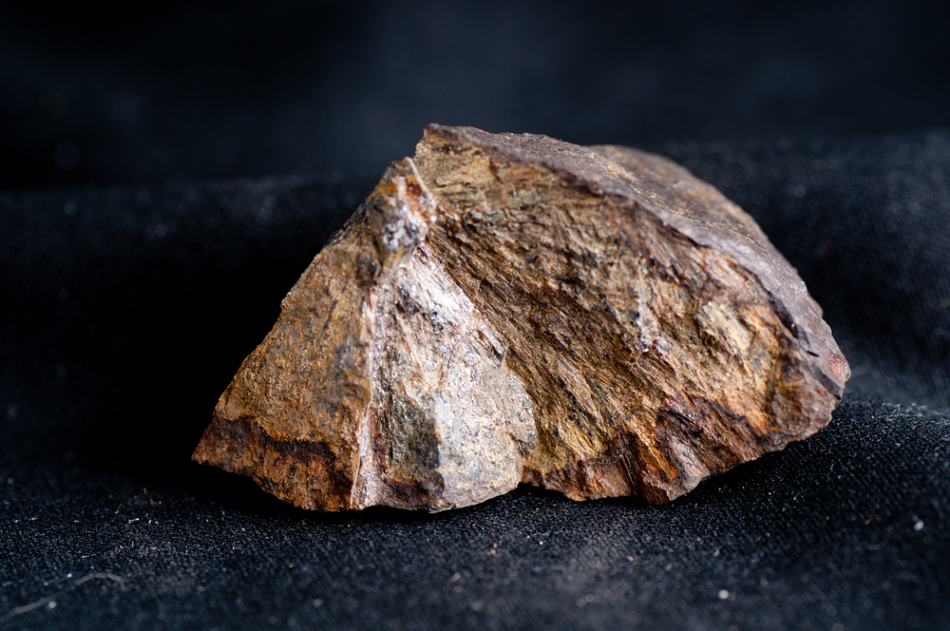Oct 21 2013

Image Credit: photominer/Shutterstock.com
Article updated on 06/03/20 by Kerry Taylor-Smith
Chemical Formula – Fe3+2 (AsO4)(SO4)(OH)·7H2O
Bukovskyite is an iron arsenate sulfate mineral that was discovered in 1967 near Kutna Hora, Czech Republic. It was named after the Czech chemist, Antonin Bukovsky, a professor of the secondary school at Kutna Hora, who first analyzed the mineral.
Properties of Bukovskyite
Bukovskyte forms nodules with a reniform or kidney-shaped surface. Under a microscope, the nodules appear as a collection of tiny needles akin to gypsum.
The following are the key properties of Bukovskyite:
Cell Data
- Space Group: P1 or P1
- a = 10.722(5)
- b = 14.079(5)
- c = 10.284(5)
- α = 93.50(4)°
- β = 115.96(4)°
- γ = 90.27(4)°
- Z = 4
Crystal Data
- Triclinic, meaning the crystal has no symmetrical elements or only an inverse center. It typically has three unequal axes, where no two are perpendicular.
- Point Group: 1 or 1 – this refers to the permutation of atoms, such that the crystal is transformed into a state indistinguishable to the starting state.
- Crystals, needlelike, elongated along [011], to .5 mm, showing {0kl} forms, terminated by {100} and {302}, may be in radial groups; generally, n aggregates, forming nodules
- X-ray Powder Pattern: 9.197 (100), 8.884 (60), 9.625 (43), 3.077 (36), 3.920 (35), 2.458 (23), 5.338 (20)
Chemical Composition
| Elements |
Content 1 |
Content 2 |
| Fe2O3 |
32.42 |
32.6 |
| H2O |
28.12 |
27.59 |
| As2O5 |
22.1 |
23.46 |
| SO3 |
16.5 |
16.35 |
| Total |
99.14 |
100 |
Content 1: from Kank, Czech Republic; original total is given as 99.32%, presence of AsO4, SO4, and (OH)1− confirmed by IR; assuming H2O− 0.69%, corresponds to Fe2.00(AsO4)0.95(SO4)1.02(OH)1.00 • 7H2O.
Content 2: Fe2(AsO4)(SO4)(OH) • 7H2O.
Optical Properties
- Optical Class: Biaxial; birefringence 0.049–0.056; very weak dispersion
- Orientation: Extinction angle = 22°
- α = n.d
- β = 1.570–1.582 (β')
- γ = 1.626–1.631 (γ')
- 2V(meas.) = n.d.
- Semitransparent
Estimated Properties
| . |
. |
| Electron density |
Bulk density (electron density)=2.33 g/cm3
note: Specific gravity of Bukovskyite =2.34 g/cm3 |
| Photoelectric |
PEBukovskyite = 17.10 barns/electron
U= PEBukovskyite x ρ Electron density= 39.88 barns/cm3 |
| Fermion index |
Fermion index = 0.005
Boson index = 0.99 |
| Radioactivity |
Bukovskyite is not radioactive |
How to Identify Bukovskyite
Bukovskyite can be identified as a greenish-gray, orange or light-yellow mineral with a yellowish-white streak and vitreous luster. The mineral exhibits earthy fractures and can be formed as needle-like crystals or fibrous structures. The density of the mineral is 2.34 g/cm3 and its hardness is 5 on the Mohs scale.
Global Distribution
Bukovskyite is distributed in the dumps and overgrown pit heaps of the Kuntery and other mines, Kank, 2.5 km north of Kutna Hora, Czech Republic. It was used for poisoning fieldmice and other field vermin and was once thought to be simply arsenic trioxide.
Occurrence of Bukovskyite and Useful Mineral Association
Bukovskyite occurs as a post-mining surficial weathering product of Fe–As sulfides. It is closely associated with quartz, pyrite, and arsenopyrite.
References and Further Reading